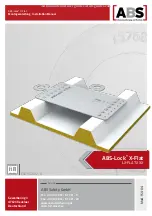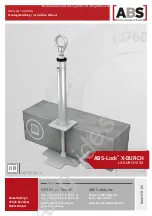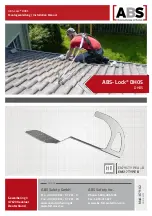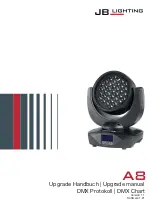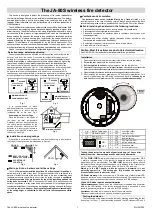
- 4 -
INSTALLAZIONE
Su una pressapaglia convenzionale per balle squadrate:
1. Individuare una superficie piatta tra i 12 e i 24 pollici
dalla parte posteriore della camera, circa a metà del lato,
sul lato non tagliato
della camera.
NOTA: Le letture dal lato del taglio della balla
risulteranno avere maggiori variazioni nelle letture e
letture complessivamente superiori.
2. Fissare con nastro adesivo la maschera di foratura in
posizione piana e praticare tutti i fori, utilizzando punte
delle dimensioni indicate sulla sagoma. Levigare le
eventuali sbavature sui fori.
NOTA: Il bordo anteriore smussato della piastra del
sensore deve stare di fronte allo stantuffo (in direzione
opposta al movimento della balla).
NOTA: La piastra del sensore deve essere montata in
pari e stretta alla parete della camera di pressatura!
3. Montare il gruppo dei componenti del sensore
utilizzando l'hardware fornito. Seguire il diagramma di
Figura 2.
NOTA: Assicurarsi che i due (2) contatti dell’ elettrodo
(bulloni per il trasporto) non stiano toccando una
qualsiasi parte metallica della camera di pressatura,
utilizzando boccole e rondelle isolanti. Fissare
saldamente ogni bullone con un dado grande.
NOTA: Assicurarsi che il bordo smussato (anteriore)
della piastra del sensore sia fissato in piano e stretto
alla parete della camera di pressatura. Fissare
saldamente con due (2) viti a testa piatta. (Se il bordo
anteriore non è fissato in piano e stretto alla parete, il
fieno passando a pressione molto forte farà leva sulla
piastra del sensore).
4. Montare un terminale ad anello sul cavo del sensore
per ogni vite di contatto. Fissare un terminale ad anello
tra due (2) rondelle di metallo e fissare saldamente con
gli ultimi due dadi (vedi Figura 3).
5. Far passare il cavo del sensore nella zona di
INSTALLATION
On a Conventional Square Baler:
1. Locate a fl at spot between 12” to 24” from the rear of
the chamber, about halfway up the side, on the UNCUT
SIDE of the chamber.
NOTE: Readings from the cut side of the bale will
result in greater variations of readings and overall
higher readings.
2. Tape the drilling template onto the flat location and
drill all holes, using the drill sizes indicated on the
template. File any burrs from the holes.
NOTE: The beveled (leading) edge of the sensor plate
must face the plunger (opposite direction of bale
movement).
NOTE: The sensor plate must mount fl at and tight to
the bale chambre wall!
3. Mount the sensor assembly using hardware provided.
Follow diagram in Figure 2.
NOTE: Make sure that two (2) electrode contacts
(carriage bolts) are not touching any part of the metal
bale chamber, by using the insulating bushings and
washers. Secure tightly with one big nut on each bolt.
NOTE: Make sure that the beveled (leading) edge of
the sensor plate is fastened fl at and tight to the
chamber wall. Secure tightly with two (2) fl at head
bolts. (If the leading edge is not secured fl at and tight
to the wall, hay passing under extreme pressure will
pry up the sensor plate.)
4. Assemble a ring terminal on the sensor cable to each
contact bolt. Place ring terminal between two (2) metal
washers and secure tightly with the last two nuts (see
Figure 3).
5. Route the sensor cable to the hitch area of the baler so
that it does not interfere with any moving parts. Secure
the cable with nylon ties or tape.
NOTE: Use attached plug cover tethered to connector
to keep out dirt and moisture!
On a Large Square Baler:
1. Use the same instructions as above, except we
recommend that you add a 1/4” thick piece of strap
iron in front of the sensor plate’s beveled (leading)
edge. This will provide additional protection to the
sensor plate.
On a Round Baler:
1. Locate a fl at spot on the sidewall or tailgate, as low as
possible to the bottom, on either side of the baler. Use
the same instructions as above.
NOTE: The beveled (leading) edge of the sensor plate
must face the pickup.
NOTE: Hay will begin to pass over the sensor as soon
as approximately 1/4 of the bale is formed.















